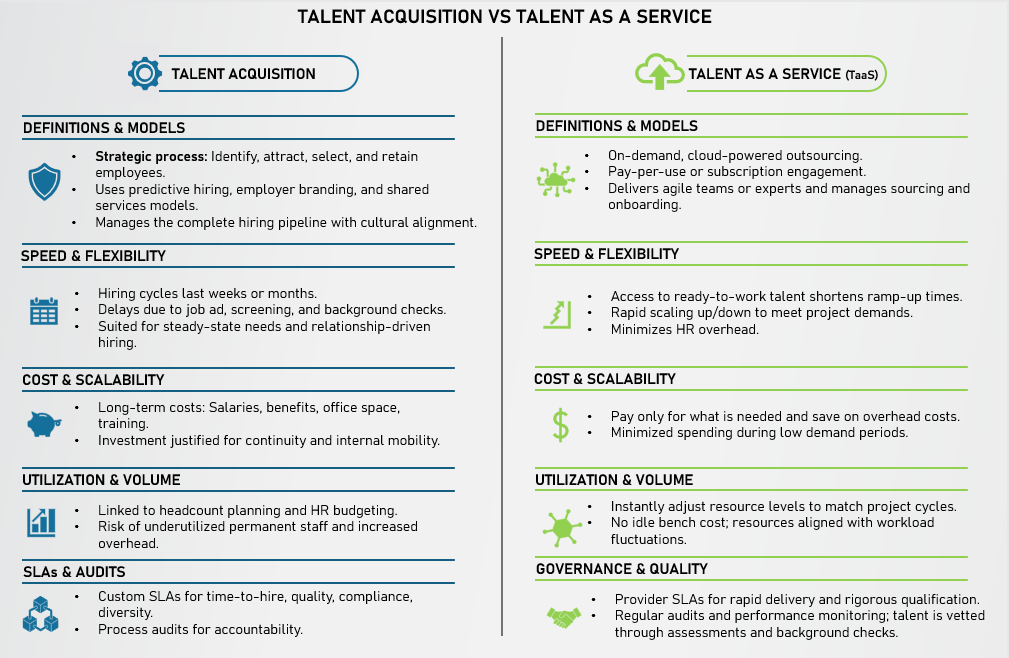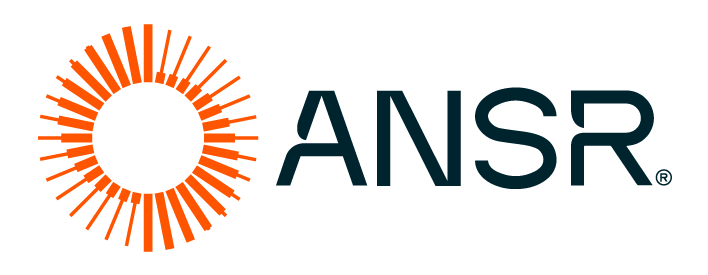Talent Acquisition Vs TaaS: Choosing the Right Model For Your Business
Talent Acquisition (TA) and Talent-as-a-Service (TaaS) offer distinct models for sourcing and deploying skills within organisations. Acquiring talent relies on structured recruitment and internal teams to meet talent needs.
TaaS differs from TA as it delivers an on-demand solution for faster, flexible access to specialised professionals. Understanding key differences in workflow, speed, cost, quality, and governance can guide organisations in choosing the right approach for their business environment.

Definitions and Models
Talent acquisition is the strategic process by which organizations identify, attract, select, and retain skilled employees to drive business objectives.
- Traditional models range from in-house teams to recruitment process outsourcing (RPO) and predictive hiring frameworks
- It typically involves the addition of candidate-facing teams (sourcing, employer branding), business-facing teams (talent advisors liaising with hiring managers), and shared services for analytics and operations
- Workflows involve HR or recruitment specialists, often leveraging Applicant Tracking Systems (ATS), structured interviews, compliance processes, and onboarding programs
- It help in managing the end-to-end hiring pipeline, from job definition to onboarding, ensuring cultural alignment and long-term retention
Talent Acquisition as a Service (TaaS) is an on-demand, cloud-powered outsourcing model.
- Providers collaborate closely, leveraging advanced technology and flexible engagement terms, offering skills on a pay-per-use or subscription basis
- Squads are created based on immediate project requirements, with professionals sourced and matched to join existing teams, sometimes using remote or hybrid modes for onboarding and integration
- Delivers specialized talent as dedicated agile teams or individual experts ready to onboard immediately, usually handling both sourcing and onboarding for rapid deployment
- Engagement is skill-specific and flexible, minimizing traditional HR overhead
Speed and Flexibility
Traditional TA cycles can take weeks or months. Particularly for hard-to-fill or specialized roles, given there is a need for job advertisement, screenings, interviews, and background checks. For steady-state needs, TA is appropriate due to its capacity for relationship-driven hiring and talent nurturing.
TaaS connects organizations directly with ready-to-work experts. This shrinks the timeline. Companies can operate with greater agility, scaling talent levels up or down for fluctuating workloads or project-specific demands.
Ramp Timelines
- Talent Acquisition:
- Weeks/months from requirement definition to productive onboarding
- Delays caused by multiple approval layers and onboarding complexity
- Talent-as-a-Service:
- Talent engagement begins in days; onboarding and deployment is streamlined
- Flex teams scale up or down as project needs change, maximizing immediate productivity
Cost and Scalability
TA typically carries long-term costs. This includes salary, benefits, office space, onboarding training, and retention programs. For larger organizations with ongoing skill needs, this investment can be justified by continuity, culture fit, and internal mobility.
TaaS operates on a pay-for-what-you-need model. Organizations save on overhead, as talent is engaged for the exact duration and scope required, minimizing spend during lulls and avoiding risks associated with long-term hires.
Utilization and Volume
- Talent Acquisition:
- Talent utilization is tied to headcount planning and HR budgeting
- Underutilized permanent staff increase overhead
- Talent-as-a-Service:
- Utilization is dynamic: organizations ramp up or down volume instantly, matching resource spend to project cycles
- No idle bench cost, improving return on investment for fluctuating workloads
Governance and Quality
Governance and quality assurance are vital for both models. TA teams adhere to internal standards, diversity policies, compliance protocols, formal onboarding, and ongoing development plans. The structured approach supports culture and quality, but speed may be compromised, especially if processes are too rigid.
TaaS leans on provider SLAs (service-level agreements) to assure rapid delivery, qualification rigor, and ongoing performance monitoring. TaaS companies maintain “always ready” pools, with talent vetted through skills assessments and background checks. Quality relies on the reliability of the TaaS provider, as cultural and organizational fit can be harder to ensure in short-term, remote engagements.
SLAs and Audits
- Talent Acquisition:
- Custom SLAs for time-to-hire, quality-of-hire, compliance, and diversity
- Internal and external process audits ensure accountability
- Talent-as-a-Service:
- Contractual SLAs for ramp timelines, project output, and replacement policies
- Providers conduct regular audits against client requirements with clear escalation paths and reporting
Decision Guide
TA is preferable for organizations seeking long-term workforce growth, culture building, and talent retention. Predictable skill needs and emphasis on internal mobility are best served through structured TA processes.
TaaS is advantageous for companies operating in dynamic markets, facing project spikes, or requiring niche skills for short-term assignments. It is ideal for any business prioritizing agility and cost control – where ramp-up speed and elasticity are critical drivers.
When to Choose Each
Choose talent acquisition when building a long-term workforce or fulfilling ongoing business needs, and opt for Talent as a Service (TaaS) when projects require specialized skills, rapid deployment, or flexible, cost-effective scale-up or scale-down of resources.
When to choose talent acquisition:
- Suitable when the goal is to develop a robust and sustainable internal talent pipeline for continuous growth and innovation
- Ideal for filling permanent positions, creating a company culture, and developing future leaders
- Works for organizations with predictable hiring needs, a focus on retention, or talent scarcity that requires long-term engagement with candidates
- Right approach for strategic expansion (e.g., new departments, locations) or industries where intellectual property and deep loyalty matter
When to choose talent-as-a-service:
- Ideal for short-term, project-based, or highly specialized assignments where speed and flexibility are critical
- Allows teams to scale headcount up or down with minimal risk and administrative overhead, accessing expert talent only when needed
- Reduces hiring, onboarding, and benefit costs by engaging pre-vetted professionals for immediate deployment
- Enables companies to try new technologies, experiment with unknown markets, or bid on projects requiring niche skills, without committing to ongoing payroll
- Well-suited for rapid pivots or industries facing high project variability and uncertainty
ANSR’s Approach to Talent Acquisition
A leading U.S. bank faced significant challenges with talent acquisition in its home market, encountering a scarcity of skilled tech professionals, high hiring costs, and long recruitment cycles. This bottleneck threatened its digital transformation initiatives.
Instead of traditional, slow-paced recruitment, the bank opted for a TaaS model. Partnering with ANSR, it established a Technical Center of Excellence in Bengaluru. This strategic shift provided access to a vast, pre-vetted talent pool.
ANSR’s AI-powered sourcing and end-to-end management of the setup, from talent acquisition to workspace and compliance, proved highly effective. The Bengaluru center quickly scaled to over 800 professionals, or 10% of the bank’s global workforce.
This successful TaaS implementation not only solved the bank’s immediate talent crunch but also enhanced operational efficiency and accelerated its digital roadmap, demonstrating a powerful alternative to conventional in-house hiring.
Talent Acquisition and Talent-as-a-Service represent two extremes of the workforce spectrum: TA provides continuity, compliance, and quality, while TaaS offers speed, flexibility, and cost efficiency.
Organizations should assess their needs before selecting the model that fits their strategy. Book a consultation with ANSR to see how our experienced team can help your business acquire talent when setting up a GCC in India.




